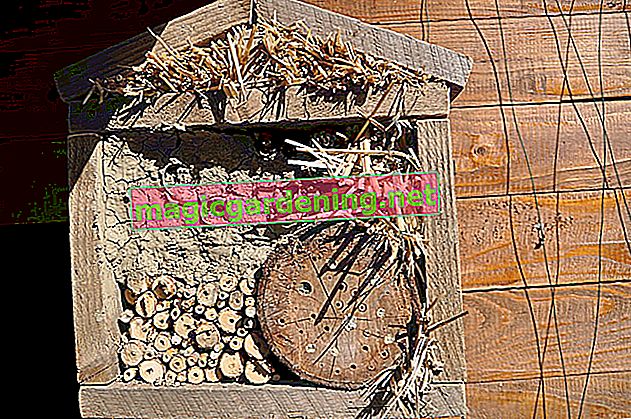
Planting milkweed properly
The planting time for milkweed begins in spring when there is no longer any fear of belated frosts from mid-May. Prepare a fine crumbly soil in the sunny to partially shaded, warm and protected location. During this time, the root ball of the still potted Euphorbia is allowed to soak itself in a vessel with water until no more air bubbles rise. Planting proceeds properly in these steps:
- Create small planting pits with 1.5 times the volume of the root ball
- Enrich the excavated earth with sifted compost and horn shavings (€ 6.39 at Amazon *) or sand
- Plant the potted milkweed down to the lower pair of leaves and water
also read
- Euphorbia ingens - about caring for cactus spurge
- The triangular milkweed - these are the most important pieces of advice for optimal care
- The cypress milkweed - a profile
Depending on the type selected, spread an organic or inorganic layer of mulch.
Care tips
A balanced supply of water and nutrients in connection with adequate winter protection are the central components of professional care. The most important measures at a glance:
- A substrate with alternating moisture and a surface that has dried out in the meantime is ideal
- Preferably water with soft rainwater or pond water
- Fertilize organically every 4 weeks during the growth and flowering period
- Before the first frost, cover bedding plants with leaves, straw and coniferous twigs
- Put the milkweed in the planter in a light, frost-free winter area
The extent to which pruning is required depends on the cultivated Euphorbia species. Cut deciduous milkweed close to the ground in autumn, while the scissors are only used in spring for wintergreen varieties. With evergreen succulents, limit yourself to thinning out before the first shoot.
Which location is suitable?
In the sunny, warm location, the milkweed thrives tirelessly in order to set decorative accents with its unusual appearance. If you look out for a nice green area in the light shade, the Eurphorbia genus will not let you down. With flexible species such as a Balkan milkweed, even a location with less favorable lighting conditions does not remain dreary and empty. As a houseplant, Christthorn and colleagues favor a bright place that, if possible, cannot get under the blazing midday sun and cold drafts.
The correct planting distance
The dimensions of a milkweed define the exact planting distance in the bed. For the most important groups within the genre, we have listed the distances below:
Plant height 15-20 cm corresponds to a planting distance of 35 cm - 6 pieces per square meter
Growth height of 30-40 cm corresponds to a planting distance of 45 cm - 4 pieces per square meter
Plant height 70-80 cm corresponds to a planting distance of 50 cm - 3-4 pieces per square meter
Plant height 90-120 cm corresponds to a planting distance of 70 cm - 2 pieces per square meter
In the tub and balcony box, shorten the plant spacing given here by 5-10 cm to create a lush appearance.
What soil does the plant need?
The majority of Euphorbia species and varieties thrive in nutrient-rich soil that is fresh and moist, humic and well-drained. In addition, the multi-faceted genus offers problem solvers for permanently moist bank locations, such as swamp spurge or for sandy, dry rock garden locations, such as roller spurge. The exotic succulents, such as Christ thorn or the poinsettia for indoor cultivation, prefer a slightly acidic substrate with a pH value of 6.0 to 6.8.
What is the best time to plant?
The best time to plant milkweed in the garden is from mid-May to mid-June. In this phase there is no longer any risk of frost, so that the perennials can quickly take root in the bed and show off their flowers and leaves. The Euphorbia have established themselves well by winter, so that the perennial species can get through the cold season in good health.
When is the flowering time?
With the right combination of species and varieties, you can enjoy the beautiful milkweed flowers all summer long. Let the following suggestion serve as inspiration:
Almond-leaved milkweed: flowering from April to June
High milkweed: flowering period May to July
Steppe Spurge: flowering from June to October
Cut out wilted flower stems regularly, this prudence contributes to a well-groomed appearance and at the same time attracts new flowers.
Cut milkweed properly
The extent to which a milkweed should be cut is determined by the type that you have in front of you. A deciduous Euphorbia can be cut back close to the ground when it is bare. In wintergreen species, leave the foliage on the plant until early spring to cut it back before the new shoots. An evergreen milkweed is content with regular thinning. The withered flower stalks should always be cleaned so that they do not affect the decorative appearance. If you want to sow yourself, wait until the seed heads have matured and the seeds have spread.
Pour milkweed
The cultivated milkweed species determines the extent of the water supply. While swamp milkweed is automatically supplied with water due to its location on the bank of the pond, the weather conditions determine the water supply of Euphorbia in the bed. If there is no rain, the perennial is watered as soon as the substrate has dried. For drought-resistant rock garden species, this maintenance measure is required less than for mighty, evergreen varieties in the perennial bed. The need for watering is regularly higher in the planter than in the bed. Check the soil every 2-3 days with a thumb test so that you can water immediately if necessary. Tropical beauties should also be sprayed with soft water, such as the poinsettia or Christ thorn.
Fertilize milkweed properly
The nutritional requirements of milkweed are at a medium level. Therefore, fertilize the plant with compost and horn shavings every 4 weeks from the beginning of growth until the end of the flowering period. In August, the feeding of nutrients in the bed should be stopped so that the succulents can mature before the first frost.
Diseases
Powdery mildew does not stop at milkweed. In this regard, the poisonous sap does little to help the succulent. If the floury-white coating spreads on the ornamental leaves as a symptom of the fungal infection, fresh milk has proven to be an effective home remedy. Add 100 ml of fresh milk (not UHT milk) to 900 ml of soft water and spray the infected Euphorbia every 2 days.
Pests
The omnipresent aphids do not care about the toxic milky sap of a milkweed. Therefore, they are among the few pests that attack the succulents. Therefore, regularly inspect the top and bottom of the leaves. Fight the lice in the early infestation stage with a mixture of 1 liter of rainwater and 15 ml of liquid soft soap (€ 17.27 at Amazon *) and alcohol.
Overwinter
Spurge species planted in the garden are conditionally hardy. It is therefore advisable to cover the plants with leaves or needles before the first frost. This precaution also applies to evergreen euphorbia, as they should not be exposed to the intense winter sun. Spurge cultivated as indoor plants, such as Christ's thorn, cannot cope with temperatures below 15 degrees Celsius and therefore move into the house in good time in autumn. You should handle all the milkweed in the planter in this way anyway, as there is a great risk that the root ball will freeze through in winter.
Propagate milkweed
While the milkweed does the propagation in the bed itself by self-sowing, you as a gardener have two further methods for breeding. The division is easy in early spring by digging up the root ball and cutting it up. A suitable section has at least 2 buds and is immediately planted at the new location. Cut cuttings in early summer to first put them in water for some time so that the toxic milky sap flows out. Then place the cuttings in a potty with poor soil in the partially shaded location until they develop their own root system.
Is milkweed poisonous?
White milky sap pours out from a milkweed that has it all. As a contact poison, the substance causes unpleasant skin irritations in sensitive gardeners. After consuming even the smallest amounts, there are severe symptoms of poisoning in humans and animals. Therefore, do not settle Euphorbia when children and pets are within reach. Carry out all planting and maintenance work with gloves.
Which milkweed species are interesting for the ornamental garden?
It is not at all easy to probe the appropriate specimens for your own garden from among more than 2,000 milkweed species. We looked around for you and put together the following selection:
Roller spurge (Euphorbia myrsinites) - the ideal perennial for full sun, dry locations
Steppe Spurge (Euphorbia seguieriana) - creates endless carpets of flowers in gravel beds and rock gardens
Almond milkweed (Euphorbia amygdaloides) - evergreen, modest beauty for partially shaded locations
Marsh milkweed (Euphorbia palustris) - plants the permanently moist pond edge
Tall Spurge (Euphorbia cornigera) - stable, lush, hardy, for beds and buckets
Mediterranean Spurge (Euphorbia characias) - a true spurge giant with a height of 150 cm
Last but not least, the wide variety of plants awaits with fascinating species for indoor culture. Above all, the Christ thorn (Euphorbia milii x Euphorbia lophogona) from Madagascar, which adorns the window sill with enchanting pseudo-flowers, lush green leaves and huge thorns, as well as the popular poinsettia (Euphorbia pulcherrima), which gives us joy in the middle of the dark season with its flowers.
How do I care for a milkweed as a houseplant?
The stars among the milkweed houseplants are Christ Village and the Poinsettia. Since both beauties come from tropical climes, they cannot tolerate temperatures below 15 degrees Celsius. On the windowsill, the potted plants want to be in a sunny to partially shaded place, protected from the blazing midday sun and cold drafts. Choose a high-quality compost-based potting soil with a slightly acidic component as the substrate. This is how maintenance works properly:
- Keep the substrate constantly slightly moist
- In the meantime, let the soil dry in the upper 2 cm
- Preferably water with soft rainwater or decalcified tap water
- Apply liquid fertilizer every 4 weeks during the growth and flowering period
- Do not fertilize or only fertilize every 6 weeks during the winter or summer rest period
At the beginning of spring, repot milkweed houseplants into fresh substrate and a slightly larger pot. This measure is necessary every year for the poinsettia. The Christ thorn only changes into a new bucket every 3-4 years.
Nice varieties
- Purpurrea: Almond-leaved purple spurge with evergreen foliage on red stems; Growth height 30-40 cm
- Black Pearl: Balkan milkweed, evergreen, with black pearl flowers in green bracts; Growth height 70-80 cm
- Golden Tower: High milkweed that impresses with its lush growth and golden umbels; Height 90-120 cm
- Fens Ruby: Premium variety with yellow flowers over initially green, later purple leaves; Height 15-20 cm
- Fireglow: Brightly colored Himalayan milkweed with bright orange-colored flowers; Height 60-80 cm
- Chameleon: Ecologically valuable, evergreen and decorative variety and wonderful autumn colors; Growth height 50 cm








